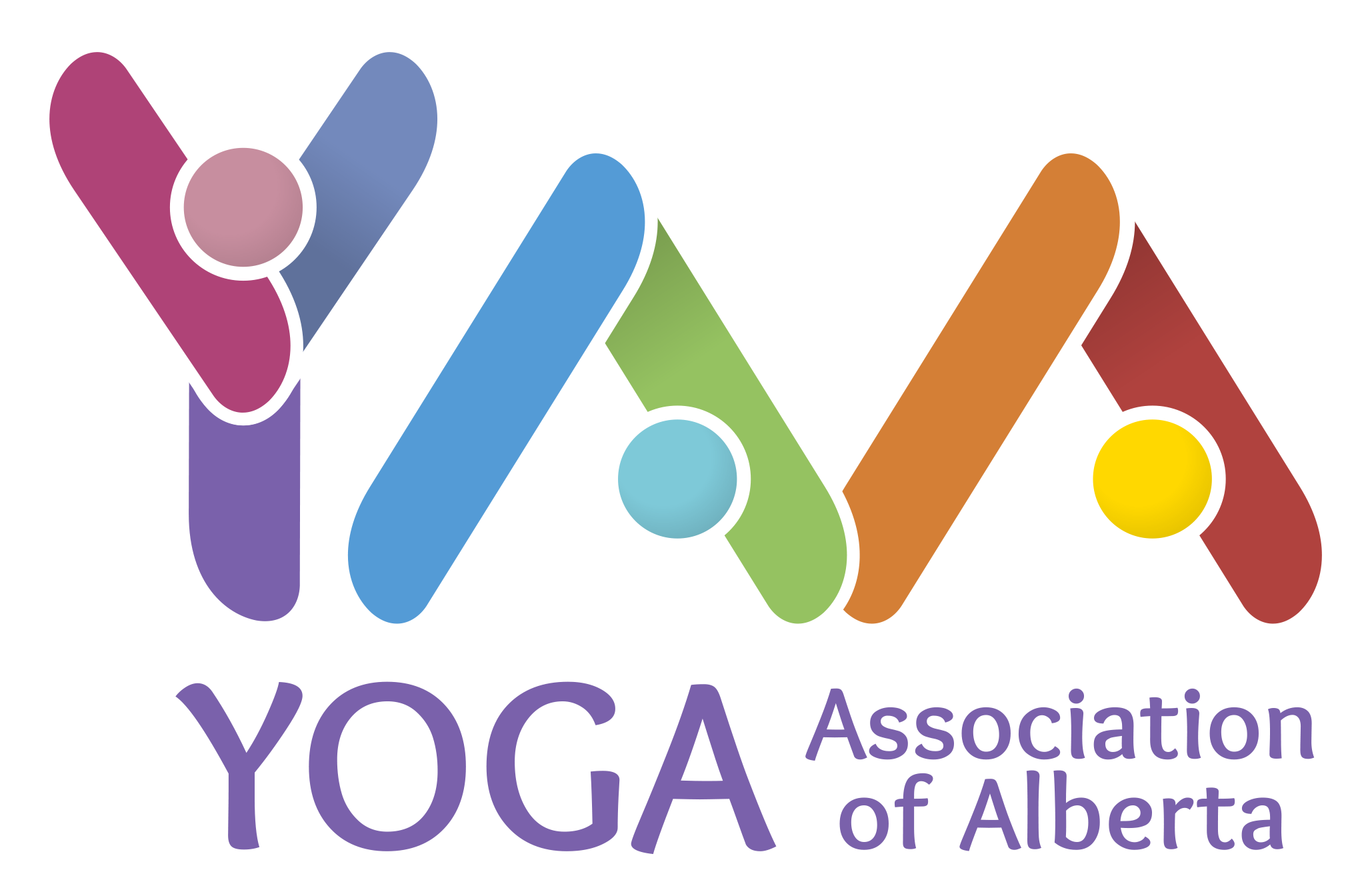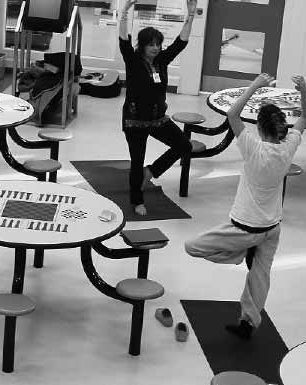Editor’s Note: The history of the YAA’s Prison Outreach Program has been published in previous Yoga Bridge articles (see Spring, 2010 and Autumn, 2012). The following three articles are written by yoga teachers who share their experience of teaching to incarcerated Albertans through the YAA’s Outreach Program.
These articles were published as a collection in Yoga Bridge - AUTUMN 2016 VOLUME 16 ISSUE 3
I. Teaching Yoga Inside and Outside by Fran Wildman
People have asked me how teaching yoga in a prison differs from teaching yoga outside of a prison. The location, of course, is different and challenging with loudspeaker messages and clanging doors. The level of education of the participants is generally different. There is less prior exposure to the concept of yoga and meditation. Many of the inmates are challenged with significant previous injuries, concentration difficulties, other health issues and emotional issues.
These differences were evident in the beginning, but at this point in the journey, I have come to realize that, as in any other yoga class, we come together, all of us on the path of life with our different challenges, wounds and stresses. The longing for stillness and peace – resting the mind and body – is the same. As we focus, the noise fades away and we move into a place of connection with our deeper selves, listening inwardly for guidance. We are no longer having a class in a prison. We are doing yoga and meditation together in a community of people.
I have come to very much value this karma yoga experience in my life. The rewards are many. I am so happy to have the opportunity to introduce the idea that no matter where a person is physically located, they can still create a place of stillness and peace within themselves. Through the practice of yoga, we can deepen the breath, quieten the mind and enhance our capacity to experience happiness and love for ourselves and others. (Edited excerpt from Spring 2010 Yoga Bridge.)
Fran Wildman is a YAA Certified Yoga Teacher.
II. Hatha Yoga, Meditation and Song by Debbie Spence
It was a Tuesday afternoon at the Percy Page Centre, Yoga Association of Alberta office. A woman walked in wearing a jacket with “Alberta Justice” printed on the back to buy a yoga mat for a retreat. I immediately asked her, “We have wanted to offer yoga classes to inmates at your institution for some time. Do you think it might be possible?” “Yes,” she replied, “I’m the Program Coordinator–Tammy. I will get back to you.”
True to her word, within a few months, this forward-thinking woman had paved the way for the YAA to offer a trial run of three yoga classes through its Outreach Program starting in January 2015. Fran Wildman, a YAA Certified Yoga Teacher, who had worked in the Corrections and Restorative Justice sectors, delivered the three classes.
The feedback from the male inmates was positive and enthusiastic. Thus, weekly classes in two of the men’s units began. However, the women’s unit was slow to come on board. They were inclined to want to talk more than participate, and many found it hard to concentrate throughout a sixty-minute-long haṭha yoga class. A different approach was needed.
It never occurred to me to actually go into the institution myself; I was simply helping facilitate others to teach yoga there. However, in September 2015, with my old Yamaki guitar strapped on my back, I entered the institution, ignoring the multiple doors locking behind me. The class I taught had three segments: a 25-minute haṭha yoga practice, followed by five to ten minutes of meditation /śav̄asana and 25 minutes of singing. It worked. The participants loved it. Weekly classes began in September 2015, following this format.
The haṭha yoga segment needs to be dynamic and constantly changing. Thus, I have found that offering a series of poses - a sun salutation series, and a series of poses for balancing and another with chairs - helps maintain the inmates’ attention. I give them copies of each series, which they can practice between classes, especially while in their cells during “lock-down.” For the meditation /śav̄asana segment, I share a guided commentary or sing a song with a spiritual or uplifting message.
After 35 minutes of a structured class, I change gears. I pull out my guitar and lead a sing-along including songs such as Hallelujah by Leonard Cohen, The Rose by Bette Midler and sometimes Folsom Prison by Johnny Cash! The power of 35 inmates singing their hearts out, voices unleashed in that sterile environment, sends shivers through me even as I write about it now. Buried emotions rise up and are released, cleansing so much sadness and sorrow. Young women, some with little education, are separated from their families. They tell me that at night it is scary, wondering about the safety of their children on the outside and who’s taking care of them. They are hungry for what yoga offers to help them deal with anxiety, depression, anger and a feeling of helplessness.
The women are brought closer together through the classes. One or two have played a song or two on my guitar. The group’s response is enthusiastic and encouraging, caring and supportive. It’s cathartic. At the end of each visit, I hand out small blessing affirmations and virtues. Many times, when they read their message, they look at me and say, “This is perfect. It’s just what I need to practise today.”
At the present time, three YAA Certified teachers lead yoga classes in six units, attracting an attendance of between 100 and 125 inmates each week. Some are long-term participants and others attend classes for two to three weeks before being transferred to other institutions or being released. Paul Yapp, YAA Certified Teacher, teaches to the Men’s 50 Years Plus unit and Boot Camp units – the participants seem to gravitate towards an intense “workout” and to enjoy some philosophy – he also teaches to the Men’s 50 Years Plus unit. Anita Christiansen, YAA Certified Teacher, has taken on the more “hard-core” units. Her determination and drive to share yoga has resulted in an increase in unit participation. I teach weekly classes to the Women’s unit. The feedback we have received include comments such as:
“I really enjoy and love this class. Thank you for coming.” “Please keep coming to the unit to teach. Yoga is awesome!” “I regret not ever paying attention to learning yoga before. I love it.” “Thank you for reaching out and giving of your precious time. It is very soothing and fun.” “Good and relaxing.” “It helps me sleep better at night.”
Teaching on the unit is a rewarding experience for me. After each class I remind them: “Contact the YAA when you get out because some studios and teachers will allow you to take yoga for free.” They are thrilled. They promise to call. Seeds are being planted.
Debbie Spence is a Yoga Association of Alberta Certified Teacher and YAA Executive Director.
III. Remand Outreach by Barbara Breau
Why offer yoga instruction at a securely locked facility? For me, three reasons easily come to mind.
First, visiting people in a locked facility is familiar to me. My 20+ years working as a practicing social worker included the occasional visit with clients who were incarcerated. I also have visited family members and friends who found themselves temporarily residing on the “inside.”
Second, the saying, “There, but for the grace of God, go I,” has been a personal and constant companion of mine for as long as I can remember. It helps me to remember that all human beings are equal in their desire to belong, to love and to be loved.
Third, once I started to experience a positive transformation in my own vessel –– what I attribute primarily to establishing a personal yoga practice –– I felt a strong desire to share. More specifically, I wanted to share with some of our most vulnerable citizens – the people I had come to know and love during my social work career.
Thus, with yoga offering in hand,” I reached out. I knocked on the door, and I knocked again and again. Finally, in 2011, the stars aligned and remand outreach yoga classes commenced. For the first year, my teaching partner was Dena Simran Kaur, a fellow YARD (Yoga Alliance of Red Deer) outreach instructor.
I taught haṭha yoga in the Himalayan Tradition and Dena taught kuṇḍalinī yoga. Sharing these two traditions offered students a blended and playful perspective of one discipline: yoga. We taught two one-hour evening classes to male inmates, alternating units each week. Females were not generally held in custody for very long at this facility at the time. Thus, instruction was given only to the male population.
Following the dissolution of the YARD outreach program and the ending of Dena’s involvement at remand, I continued teaching solo until the beginning 2014. This past January, at the request of the remand centre, I resumed teaching yoga classes. Female inmates are now been given the first option to attend.
Currently, a class is 45 to 60 minutes of haṭha instruction. Physical capacity, medical issues, emotional state, verbal comprehension and students’ ages vary in each class. Consequently, specific instruction is adjusted based upon who shows up for class and how the participants are feeling.
Not knowing when students might have the opportunity to attend another class, due to individual life circumstances, it is my clear intention to introduce yoga as a natural and relevant path to help calm busy minds. Each class is taught as a basic, beginner introduction to yoga. I take time to explain how regular yoga practice assists with tension reduction and serves as a means to enhance human experience in a beneficial way. I offer my personal belief that yoga, though an ancient discipline, continues to be relevant today, regardless where we lay our heads at night.
Laughter is a theme I introduce at the onset, to help create and maintain a relaxing atmosphere. I usually share a couple of my humorous yoga-learning experiences, for example, how I skipped out of śavāsana for my first full year of classes because I thought it was a waste of my time!
Overall, the yoga students at remand appreciate the instruction. Even those who are quiet and less interactive will often make their way to the front after class to offer words of gratitude. Simple, yet gracious comments, such as: “Thanks for coming in to teach us.” “That was fun.” “I really enjoyed class,” are sincerely expressed and heartfelt.
Sometimes students ask: “Where can I get lessons when I get out?” “How can I learn more?” “Who do I contact?” These questions serve as experiential evidence of the relevance of yoga for remand centre inmates. Students, who express an intention to investigate further, demonstrate that the planted “outreaching” yoga seed has been nurtured and is preparing to sprout. What a boon!
It is truly a privilege for me to be provided opportunity to offer yoga to these students. Our shared laughter and the students’ gratitude motivate me to continue. I am humbled by their honesty and courage to participate; and grateful to all those who have brought the endeavour to fruition.
Barbara Breau is a YAA Certified Intermediate Teacher. She is a long time student in the Himalayan Yoga Tradition and is currently registered in the Continuing Studies Program, mentored by Keely Scott.

